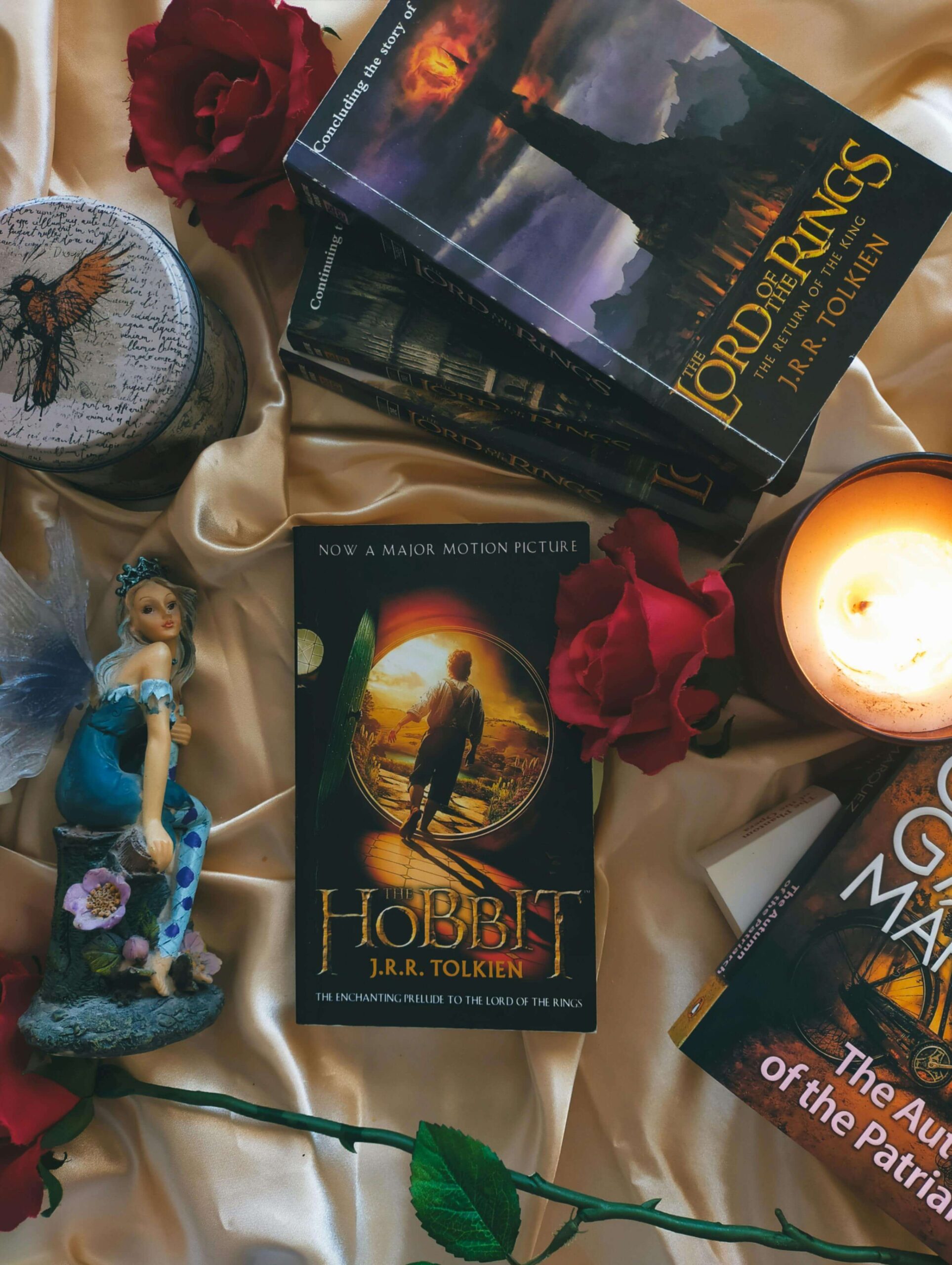
Writing a novel from scratch takes more than creativity. You need structure, vision, and a deep understanding of storytelling.
If you’re serious about becoming a published author, especially in fantasy fiction, studying J.R.R. Tolkien books is one of the smartest investments you can make in your craft.
Tolkien wasn’t just a professor of language and literature at Oxford. He was the architect of Middle-earth, the father of modern epic fantasy, and the mind behind stories that have sold over 600 million copies worldwide.
The Lord of the Rings trilogy alone has sold more than 150 million copies and been translated into more than 40 languages. His influence runs so deep that nearly every successful fantasy author working today owes something to his legacy.
What makes J.R.R. Tolkien books essential for aspiring authors is how they reveal the mechanics of great storytelling in slow motion.
You get to see how he builds tension over chapters, plants subtle hints that later bloom into major revelations, and creates characters that feel like they walked straight out of ancient folklore.
I remember reading The Fellowship of the Ring for the second time—this time as a writer—and realizing how deliberately every sentence carried weight. It wasn’t just plot; it was pattern, pacing, and purpose.
He didn’t publish in bulk or chase trends. He crafted. Every map, every song, every made-up language had roots. So when you study his books, you’re not just reading stories. You’re learning how to construct them.
If you want your own novel to carry the kind of emotional depth and world-spanning scope readers remember decades later, this is where you begin.
Why You Should Read J.R.R. Tolkien Books as an Aspiring Author
Whether you’re working on a high fantasy novel or a grounded character drama, there’s a lot you can learn from books by J.R.R. Tolkien. He spent years crafting not just stories, but fully living worlds.
His writing style, world-building technique, and layered themes make his novels essential study material for anyone who wants to write fiction that stands the test of time.
Tolkien developed entire languages before he even finished writing the first chapters of The Hobbit. He used his deep knowledge of Norse mythology, Anglo-Saxon literature, and philology to build a literary universe that felt real.
In a time when many books rely on formula, Tolkien’s work still feels handcrafted and intentional.
You’ll notice it the moment you start paying attention to the details—how the names of mountains, rivers, and regions sound like they belong to a culture with centuries of history behind them. That’s not by accident.
He made sure every place, name, and event had a place in the larger puzzle.
Tolkien once said that “the invention of languages is the foundation,” and he meant it. For him, words shaped the world. If you’ve ever struggled to make your fictional setting feel alive, this approach flips the switch.
You’re no longer just naming a kingdom. You’re designing a civilization with rhythm and roots.
What’s even more inspiring is how Tolkien wrote with long vision. He wasn’t rushing to meet a trend or chase a bestseller list. He let the story grow slowly, layering meaning through generations of characters, legends, and landscapes.
That kind of storytelling reminds you that great fiction isn’t built overnight. It’s built with care, with curiosity, and with a relentless desire to get it right. Studying J.R.R. Tolkien books gives you a front-row seat to that process.
The J.R.R. Tolkien Books You Should Study Closely
If you’re trying to level up your writing skills, diving into J.R.R. Tolkien books is one of the most rewarding steps you can take. These aren’t just stories to enjoy. They’re works to study.
From pacing and dialogue to epic structure and deep world-building, Tolkien gives you a masterclass in what it means to write fiction with weight, purpose, and staying power. Here’s where to start and what to look for in each book.
The Hobbit (1937)
This is your entry point. At a glance, The Hobbit looks like a simple children’s story, but when you study it as a writer, it offers a masterclass in tonal shifts, foreshadowing, and pacing.
Tolkien introduces you to a reluctant hero, a multi-racial cast of characters, and a world full of mystery without ever overwhelming you.
What stands out is how naturally the story grows. One moment you’re watching Bilbo fumble through breakfast with dwarves, the next you’re deep in the Misty Mountains, confronting goblins and riddles in the dark.
And none of it feels forced. You can feel the rhythm in Tolkien’s storytelling—the rise and fall of action, the carefully timed humor, the slow buildup of stakes. The tension increases chapter by chapter, and somehow, you’re never lost.
As a writer, that kind of control over pacing and atmosphere is pure gold.
There’s also something smart and subtle happening beneath the surface: The Hobbit teaches you how to introduce high fantasy concepts through small, familiar moments. A hobbit in a hole. A map with a secret message. A journey that starts because someone shows up at the door.
That kind of grounded beginning makes even dragons and magic feel believable later on. When I first studied this book seriously as a writer, I realized how every line carried purpose—how each joke or description nudged the story forward while planting seeds that bloom later.
You can learn how to create an accessible fantasy setting, use dialogue to build character without exposition, and develop a sense of adventure with rising tension. If you want to write stories that grow bigger with every chapter while keeping readers grounded in the characters, The Hobbit gives you a perfect model to follow.

The Lord of the Rings Trilogy (1954–1955)
- The Fellowship of the Ring
- The Two Towers
- The Return of the King
This trilogy defines the high fantasy genre. The journey of Frodo Baggins shows you how to evolve characters over time, manage multiple storylines, and weave deep themes like temptation, sacrifice, and friendship into the plot.
What impressed me most when rereading it as an aspiring author was how nothing is wasted. Even the quiet moments—like Sam talking about stars in Mordor—carry emotional weight.
You begin to see how Tolkien layers meaning through contrast: small hobbits in a vast world, personal burdens in the face of global doom. And somehow, it all fits together.
As a writer, observing how he juggles multiple POVs, timelines, and emotional arcs teaches you to manage complexity without confusion.
What really stands out is how grounded the emotional stakes feel, even in the middle of massive battles and mythical quests. Frodo’s burden isn’t just the Ring—it’s the slow erosion of his spirit, the constant test of will.
Meanwhile, Aragorn’s arc is about stepping into destiny, and Sam’s is about unshakable loyalty. Each character changes, and not always in ways they want.
That’s the kind of transformation that makes readers care. It teaches you how to write characters who earn their growth through experience, not just exposition.
Tolkien builds not just a fantasy world, but a complete moral framework. As an author, that’s something you can study: how to embed values and purpose into fiction without turning it into a sermon.
When I studied these books again while working on my own manuscript, I took notes on how Tolkien used silence, moments between the noise, to deepen a scene. Sometimes, it was a glance, a memory, or a line of dialogue that said more than a whole chapter.
And as I worked through my own plot twists and turning points, I kept coming back to how The Lord of the Rings stayed emotionally steady even while the stakes kept rising. That kind of structure is something worth learning from line by line.
The Silmarillion (1977)
If you want to understand Tolkien’s depth as a writer, this is where you go next. The Silmarillion reads like a mythology textbook for Middle-earth. But when you’re writing your own epic, this book teaches you how to:
- Build a universe with centuries of backstory
- Use myth as a structural foundation
- Develop a consistent tone across generations of characters
This isn’t light reading, but it’s worth every bit of your attention. Think of it as Tolkien’s blueprint. He lays out creation myths, divine hierarchies, wars, betrayals, and love stories that all shape the future you see in The Lord of the Rings.
If you’ve ever spent hours adjusting a single paragraph, you’re in good company. Tolkien did the same.
As a writer, the lesson is clear: stories become richer when you understand the roots. You don’t have to include everything you’ve created in your novel, but knowing that backstory will shape how you write each moment. Tolkien made Middle-earth feel ancient because he treated its past like it mattered.
What struck me the first time I studied The Silmarillion seriously was how much weight each event carried. Even a single choice by a character, like Fëanor’s obsession with the Silmarils, echoes across the entire timeline like a domino effect.
If you want to understand how cause and consequence work in long-form storytelling, this book gives you a crash course in that through beautifully layered narrative.
And then there’s tone. From the opening lines describing the music of the Ainur, you know you’re reading something epic. Tolkien doesn’t shift his voice. He keeps it elevated, mythic, and rhythmic all the way through.
That’s no accident. It teaches you how to maintain consistency, even when jumping across different eras, characters, and conflicts.
If you’ve ever sketched a fictional timeline or a family tree for your story, this book will help you think bigger. It shows you what happens when you zoom out and how that long view can bring more gravity and meaning to the moment-to-moment scenes in your main narrative.
Unfinished Tales and The History of Middle-earth Series
These posthumous collections give you a behind-the-scenes look at how Tolkien worked. You’ll see his raw drafts, revisions, alternate plot lines, and narrative experiments. And from that, you learn the biggest lesson: even literary geniuses wrestle with structure, character arcs, and rewriting.
Some of my favorite discoveries came from reading these. You get to watch Tolkien change his mind, rethink relationships, and completely rework certain events. It’s strangely comforting.
If you’ve ever spent hours adjusting a single paragraph, you’re in good company. Tolkien did the same. His process was slow, deliberate, and filled with handwritten notes and crossed-out pages.
What surprised me was how detailed his thinking became, even for scenes that never made it into the final books. You’ll find multiple versions of the same event, with slight shifts in dialogue or emphasis, as if he were tuning an instrument until it hit the right note.
It reminded me that sometimes a good scene doesn’t come fully formed. It arrives in pieces, through trial and error, through second-guessing and rewriting, and that’s okay.
These collections also show how Tolkien was never finished learning his own world. He returned to stories years later to expand on ideas, tighten logic, or add depth.
As a writer, seeing that kind of patience and persistence taught me to slow down and listen to the work itself. Some drafts need time to mature. Some characters reveal themselves on the third rewrite, not the first.
Reading these gives you permission to take your time and treat writing like a long-term relationship, not a sprint. It reminds you that writing is an act of building, tearing down, and building again until the story finally speaks the way it should.

Understanding Tolkien’s Writing Style
Tolkien’s writing style is poetic without being pretentious. He used rhythm, old-world phrasing, and carefully placed descriptions to create atmosphere. He wasn’t afraid to slow down the story when it served the narrative. That level of control is something you can study and apply.
His sentences often roll like verses, especially when describing landscapes or introducing ancient lore. You feel the influence of his background in philology—how he selects words not just for clarity, but for cadence.
That’s why so many passages feel memorable, even if they’re describing something as still as a forest or as quiet as a star-lit sky. It’s all about flow. His prose teaches you how the sound of a sentence can affect its emotional weight.
For example, in The Two Towers, the pacing deliberately slows when Sam and Frodo cross the Dead Marshes. The language becomes more visual, eerie, and elongated. That shift in tone isn’t random; it mirrors the growing psychological burden on the characters.
When I went back to study that scene, I noticed how even the verbs slow down—“crept,” “lingered,” “drifted.” You feel like you’re moving through fog.
As a writer, that taught me how sentence structure and word choice can echo mood. If a moment in your story needs dread, or awe, or reflection, Tolkien shows how to make your prose feel it without spelling it out.
The real magic? He knew when to hold back. He didn’t overload every page with adjectives or purple prose. He chose moments where the atmosphere mattered most, where slowing down would deepen the reader’s connection. That balance is something every writer can study and sharpen.
Tolkien’s Approach to World-Building
If you want to learn how to write fantasy like Tolkien, start with how he built Middle-earth:
- He created functioning languages (Elvish, Dwarvish) with grammar and syntax.
- He mapped his world before writing the stories.
- He developed genealogies, political systems, and religions.
Tolkien treated his world like a living organism. Every region had its own culture, every race its own mythos, and every historical event a ripple effect across the land. If you’ve ever tried to name a fictional city and got stuck, studying his maps and appendices will change how you think about world-building.
What makes his approach so powerful is that nothing exists in isolation. The names of mountains carry the weight of fallen kingdoms. The songs sung by characters reflect real events in their past.
Even the stars above them have a creation story. Tolkien’s world isn’t just large. It’s layered. That’s what makes it believable. He wrote with the mindset of an archaeologist uncovering history, not just an author inventing scenes.
When I built my own fantasy world, I kept running into dead ends—cities that felt flat, histories that sounded generic. Then I opened The Return of the King appendix and saw how Tolkien detailed lineage after lineage, down to rulers with barely a mention in the main plot.
That changed everything. I realized the trick wasn’t creating endless facts. It was making each piece connect to something else. He made sure every place, name, and event had a place in the larger puzzle.
If you’re serious about writing immersive fantasy, take notes on how Tolkien layers culture, language, and time. His maps aren’t decorations. They’re blueprints. His languages aren’t gimmicks. They’re proof that every detail, no matter how small, shapes the way a world feels when readers step into it.
Writing Lessons You Can Apply from Tolkien
Tolkien wrote for readers who wanted to get lost. And that’s something every aspiring author can aim for: immersion.
Here are key takeaways from his methods:
- Don’t be afraid to take your time building a world that lives beyond your protagonist.
- Let your characters evolve naturally through trials, not just plot twists.
- Create lore, even if you won’t use all of it. The reader will feel the depth.
- Revise without fear. Even Tolkien’s first drafts were messy.
Tolkien didn’t rush through storytelling to get to the action. He allowed characters to stumble, pause, and grow in ways that felt honest.
Sometimes it took them entire chapters to make a single choice, but that slow burn made every decision matter more. You learn that pacing isn’t the enemy of engagement when the emotional core stays strong.
What makes J.R.R. Tolkien books essential for aspiring authors is how they reveal the mechanics of great storytelling in slow motion.
When I wrote my first novel, I kept Tolkien’s sense of scale in mind. I knew I wouldn’t create a world as massive as Middle-earth, but I could echo the way he built purpose into every setting, every character choice, and every conflict.
Even small towns in my book had local legends. Even quiet scenes carried weight, because I was thinking about what each moment revealed, not just about the plot, but about the people living in that world.
Tolkien also reminds you that rewriting is part of the job. His notebooks were filled with crossed-out names, reimagined timelines, and tangled drafts. That kind of transparency—seeing how long it took him to find the right shape—gave me the freedom to stop chasing perfection in the first try.
His process shows you that storytelling is a slow layering of meaning, voice, and history. You’re not just writing a novel. You’re building something that should feel lived in.
Recommended Reads if You’re Inspired by Tolkien
If you want to explore other authors who studied Tolkien’s work or adopted his narrative DNA:
- Brandon Sanderson: Known for his intricate magic systems and structured storytelling. His Mistborn and Stormlight Archive series are masterclasses in how to build vast, rule-bound fantasy worlds without losing emotional stakes. You’ll notice how he balances complexity with clarity—a skill Tolkien valued too.
- Ursula K. Le Guin: Her Earthsea series reflects similar mythic tones and internal logic. She takes a quieter, more philosophical approach, but her attention to language, power, and culture echoes Tolkien’s. Le Guin once said that fantasy should reflect “truth” in ways realism can’t—and you feel that deeply in her work.
- Patrick Rothfuss: His lyrical prose in The Name of the Wind channels Tolkien’s rhythm and depth. You can hear the music in his sentences, the way he draws you into a character’s internal world through sound and silence. Like Tolkien, Rothfuss builds from oral storytelling traditions and infuses every passage with memory.
Also, read The Letters of J.R.R. Tolkien and Tom Shippey’s The Road to Middle-earth if you want to analyze his thought process. Those give you access to the mind behind the myth—to his doubts, decisions, frustrations, and breakthroughs.
When I read his letters, I started to understand how intentional every creative move was. And Shippey, who was a philologist like Tolkien, breaks down the linguistic layers and moral philosophies with sharp clarity. If you’re serious about growing as a fantasy author, these texts are more than reference. They’re mentorship in print.
Why Tolkien Still Matters for Writers Today
Tolkien matters because he proved that stories can be both epic and intimate. He showed us how myth and meaning can live side-by-side, how fantasy can tackle real-world themes like corruption, courage, loyalty, and mortality.
He didn’t write to follow trends. He wrote because the story needed to be told, and that’s a mindset every author can learn from.
What makes J.R.R. Tolkien books feel enduring is the way they trust the reader. He didn’t rush to explain everything. He allowed mystery to linger, characters to speak through silence, and landscapes to breathe.
That kind of storytelling stays with people. It reminds you that books aren’t disposable content. They’re experiences. I’ve met readers who revisit The Lord of the Rings every few years, and each time, they discover something new. That only happens with stories built to last.

In today’s noisy, algorithm-driven publishing world, Tolkien’s books remain a powerful reminder: build something timeless, and readers will find you. Even if it takes decades. Even if it goes against what’s currently selling.
Because when you study J.R.R. Tolkien books, you’re not just learning how to write fantasy. You’re learning how to build stories that outlive you.
The kind people reread, recommend, and pass down. The kind that doesn’t need a viral moment to matter. The kind that makes you want to slow down, think deeply, and write with conviction. That’s what we need more of right now. And that’s why Tolkien still matters.





This text provides a detailed explanation of how cookies are used on a website to enhance user experience and analyze traffic. It categorizes cookies into necessary, functional, analytical, performance, and advertisement types, each serving a specific purpose. The information is presented clearly, making it easy for users to understand and manage their cookie preferences. However, the text could benefit from a more concise summary for users who prefer quick insights. How can users ensure their privacy is fully protected while still benefiting from the functionalities provided by these cookies? WordAiApi